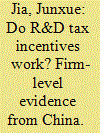| Srl | Item |
| 1 |
ID:
159069


|
|
|
|
|
| Summary/Abstract |
Tax incentives have been used worldwide to encourage firm R&D, but there is little evidence on their effectiveness as a policy tool in developing countries. We use a panel dataset of Chinese listed companies covering 2007 to 2013 to assess the effects of tax incentives on firm R&D expenditures and analyze how institutional conditions shape these effects. Our results show that tax incentives motivate R&D expenditures for our sample firms. A 10% reduction in R&D user costs leads firms to increase R&D expenditures by 3.97% in the short run. We also find considerable effect heterogeneity: Tax incentives significantly stimulate R&D in private firms but have little influence on state-owned enterprises' R&D expenditures. Moreover, the effects of tax incentives are more pronounced for private firms without political connections. Hence, reducing political intervention complements tax incentives' capacity to foster firm R&D in developing countries.
|
|
|
|
|
|
|
|
|
|
|
|
|
|
|
|
| 2 |
ID:
112324


|
|
|
|
|
| Publication |
2012.
|
| Summary/Abstract |
The Renewable Portfolio Standard (RPS) of the State of Illinois specifies a schedule for the fraction of electricity produced from wind to be phased in through 2025. The price of electricity due to implementation of RPS in order to achieve a six-year payback on investment on new wind farms was estimated for six scenarios that examined the effect of electricity consumption growth rate, production tax credit of $0.022/kW h or unrestricted investment tax credit of 30%, and projected changes in installed project costs. In all cases, the electricity price was found to be dominated by the installed project cost (capital cost). Thus, any policy that affects the capital cost directly or indirectly would have a significant effect on the electricity price. Whereas investment tax credit has a direct effect, policies that encourage technology improvement and improve transmission lines would have a similar effect of lowering the capital cost. Carbon tax, on the other hand, would increase the electricity price to the consumers, although it offers other benefits.
|
|
|
|
|
|
|
|
|
|
|
|
|
|
|
|